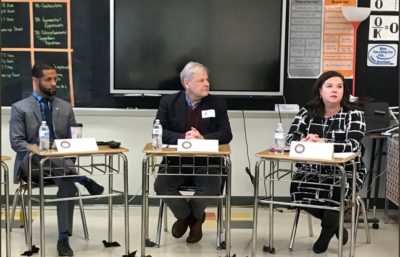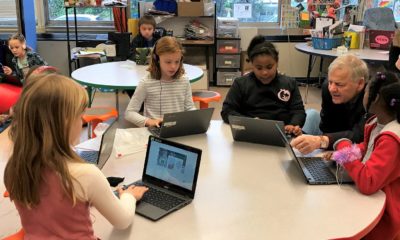The Parkland shootings vividly reignited the gun safety debate all over America, including our Virginia House of Delegates. Republican and Democratic delegates, however, responded quite differently. The Republican leadership decided their focus should be narrow, and, through the Speaker, created the House Select Committee on School Safety, a bipartisan 22-member group to which I was appointed.
Democrats are examining the issue through a broader lens, and created our own task force, the Safe Virginia Initiative (SVI), which will convene meetings around the state to discuss gun safety initiatives. Delegates Eileen Filler-Corn and Kathleen Murphy, the co-Chairs of SVI, have invited Republicans to join their group, but no one has yet embraced the invitation. Both efforts have the potential to bring positive change to the Commonwealth, even as each has a different focus. Virginians realize that “thoughts and prayers are no longer enough” to address our problems.
Each committee met recently for the first time, in very different places, and heard testimony with a different emphasis. The contrast was dramatic.
HOUSE SELECT COMMITTEE FIRST MEETING
The House Select Committee on School Safety met on April 26 in the General Assembly Building in Richmond. Composed of 12 Republicans and 10 Democrats, the group heard testimony about what the state has been doing in the last several years to protect our students, followed by a general discussion about school safety. This committee has been specifically instructed by the Speaker—a retired teacher—not to discuss arming teachers, a proposal advocated by the President of the United States, nor the broader question of gun safety. The committee has come under fire for not considering the underlying challenges of gun violence (Virginian Pilot, May 7, 2018). The first meeting, and the working subcommittees announced, suggest that its recommendations will likely focus on:
- Physical changes that can be made to schools — entrance control, locks in classrooms, safety glass;
- Responses of the schools and law enforcement to school attacks; and
- Student behavior and intervention such as mental health counseling and conflict resolution.
SAFE VIRGINIA INITIATIVE FIRST MEETING
The first meeting of the Safe Virginia Initiative (SVI) also convened in Richmond, but in a recently built and beautifully designed school in an inner city neighborhood that had seen numerous incidents of gun violence over the last several years. Walking through metal detectors at the entrance was somewhat jarring, in light of what I’ve been hearing from our local school divisions about the importance of creating a welcoming environment in our schools, but it was a clear example of how different communities may need to respond differently to security issues.

While the Select Committee heard data and statistics about what the state has been doing in schools, the SVI heard troubling reports of families torn asunder by gun violence. A recent study conducted by the Richmond Public Schools reported that 23 youngsters under the age of 12 had been victims of gun violence in Richmond communities between September 6, 2016, and May 7, 2017, and that five had died from gunshot wounds. Some of these shootings were a result of gang violence; others were suicides. The school in which the meeting occurred was new and felt secure, but the neighborhoods surrounding it were experiencing violence almost daily. We must not ignore the crucial point that for many inner-city neighborhoods, the threat of mass school shootings, while troubling, is less of a concern than all-too-frequent gun violence in their communities. This perspective was voiced powerfully by the testimony of an African-American grandmother of a child recently killed in gun violence, who showed us a picture of her lost loved one and stated this death could have been prevented if the perpetrator had not had access to a gun.
LISTENING TO THE PUBLIC

Over the past few weeks, I have visited several local schools and have spoken with administrators, teachers, law enforcement, and students. It’s clear to me from these experiences that:
- We have tremendously dedicated personnel who are constantly exploring new ways to make schools safer.
- Almost no one supports arming teachers or turning schools into fortresses.
- School violence is only a small part of a larger problem of violence and gun violence in our communities and our nation.
- Building relationships and productive social networking is the key to reducing threats of students hurting themselves or others.
FOLLOWING THE DATA

It is important to recognize what the data say about school safety and gun violence. One of the foremost experts in this field, UVA professor Dewey G. Cornell, argues that schools are among the safest places for youngsters to be. He cites data showing that over the last 20 years in this country, students are 67 times more likely to be murdered outside of school than at school, and that, according to the Centers for Disease Control (CDC), there have been over 500,000 shootings outside of schools over the last 5 years, many more than have occurred on school grounds. (You can view Dr. Cornell’s March 20 testimony here.) Additionally, the FBI has found that homicides are ten times more likely to occur in a restaurant than in a school.
Certainly, the presence of firearms is taking a toll. Over the past 10 years, CDC reports an average of 32,575 deaths due to firearms; 62% of these were due to suicide. But killings tend to occur in the broader community, not on school grounds.
VIRGINIA INITIATIVES

The general public is largely unaware of the efforts our Commonwealth has made in the area of school safety. Local school divisions have been required to conduct school safety audits since 1997, and we are the only state that requires each school board to create multidisciplinary “threat assessment teams” to address the possibility of school violence. The Virginia Center for School and Campus Safety within the Commonwealth’s Department of Criminal Justice Services provides oversight and collects data associated with these initiatives, and its reports reveal the progress we have made, and the challenges we still face. In 2016-2017, schools conducted a total of 9,238 threat assessments, 98% of which involved students in the schools. Half of those were threats from students seeking only to harm themselves; this is consistent with data that show that suicide is now the 2nd leading cause of death among young people. Fortunately, threat assessment works; Cornell reports that less than 1% of students seen for a threat assessment carry out their threats to kill or maim others. The Commonwealth also has a School Safety and Security Grant Fund, typically budgeted at $6 million per year, which allows school divisions to access money for technical improvements for safety. Albemarle and Charlottesville have both used this fund for a variety of designed safety improvements.
What the Commonwealth has failed to do, however, is to pass reasonable common sense gun safety measures. Over 70 proposals were made during our last legislative session, most of which were defeated on party-line votes in small subcommittees.
NEXT STEPS

Both the Select Committee and the Safe Virginia Initiative will continue to meet over the summer and into the fall. The Select Committee has a website, where citizens can post ideas, and the House Democratic Caucus hopes to create one for the SVI soon. Each body will develop recommendations for the 2019 General Assembly session. Significantly, each group is emphasizing “consensus driven” approaches. For the Democrats, this means that the body will not support gun safety initiatives unless embraced by a broad cross section of the Commonwealth.
As for me, I will continue to attend both Select Committee and SVI meetings and hear the testimony. And I will continue to visit our local schools and listen to you.
Based on what I know at present, I hope both committees will seriously consider adopting the following recommendations:
- Greater funding for mental health counselors as part of the Standards of Quality (SOQ). If we increase the requirement for counselors, and link it to funding, we can potentially identify youngsters in crisis earlier, and help them address their challenges well before they might threaten to hurt themselves or others.
- Providing “best practices” design specifications for improving physical security for both new and existing school buildings.
- Funding additional support for school resource and security officers where localities desire and need them.
- Universal background checks for persons seeking to buy weapons.
- Prohibiting those under the age of 21 from purchasing assault-style weapons.
- Developing a new form of Protective Order that will allow judges, under defined criteria, to remove weapons from a person during a mental health crisis, until that crisis has been resolved.
Your input is important to the process, and I hope you will participate, either by writing to me or entering your comments on the committee websites.
